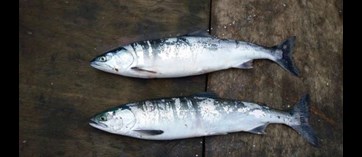Identify and report Pacific pink salmon
Pacific pink salmon (also known as humpback salmon) is not a native fish to Welsh waters. It could carry diseases which threaten native fish stocks.
How to identify a Pacific pink salmon
It is possible that at first sight, a fresh pink salmon may be confused with a small Atlantic salmon.
Pacific pink salmon:
- large black oval spots on the tail
- bluish back, silver flanks, and white belly
- usually smaller than Atlantic salmon (40-60cm in length)
- much smaller scales than an Atlantic salmon of the same size
- very dark mouth and tongue
- breeding males develop a distinctive hump
In contrast, the native Atlantic salmon typically has:
- no spots on the tail
- one or two black spots on the gill cover
- spots on the back above the lateral line
- usually larger than a Pacific pink salmon (up 100cm in length)
- larger scales
- pale mouth and tongue
- thicker base of tail than a pink salmon
Features of pink salmon in ocean phase
When fresh from the sea, pink salmon are steel blue to blue-green on their backs, silver on the flanks and white on their bellies.
There are large black spots on the backs, upper flanks, adipose fins and tail – some of the spots on the tail can be as large as the fish’s eyes. They are very uniform in size, reaching only 40 to 60 cms in length.

Image courtesy of the Environment Agency.
Features of pink salmon in freshwater phase
Breeding males are immediately identifiable because of their “hump” and they will almost certainly be running milt when close to spawning. Their black tongues and heavily spotted tails are also very obvious.
Females will also have heavily spotted tails and adipose fins. The fish may have pinkish-brown hue on the flanks dependent upon the time spent in the river.


Image courtesy of Helmsdale DSFB & River Dee Trust and Nigel Fell Atlantic Salmon Trust and Tweed Foundation.
Report Pacific pink salmon
If you are confident that you have caught a pacific pink salmon:
- do not to return the fish to the water
- dispatch the fish humanely
- record capture date, length and weight and fork length measurement
- record the sex
- record the location of capture (grid reference if possible)
- report the capture to our 24 hour incident hotline as soon as possible
if possible, also:
- take a photograph of the fish, preferably of the flank, tail and the mouth
- obtain a scale sample from the fish and store these in a paper envelope
- obtain a fin clip (an adipose fin clip or a clip from any other fins) as well as a sample of dorsal muscle tissue (at least 2cm x 2cm)
- freeze and store the fish whole as soon as possible after capture
- store the capture details together with the fish in a separate sealed plastic bag if possible
This will help the us, and fisheries researchers, better understand how to manage the arrival of pink salmon in the UK.
Finding a dead specimen
If you find a fresh, dead specimen, report this to our incident hotline.
Atlantic salmon
If you are not absolutely confident that you have caught a pink salmon, then the fish should be released back to the river alive where it was captured.
This is to ensure that no Atlantic salmon are retained in error. It is an offence to take Atlantic salmon in any Welsh waters, and we will take enforcement action against anyone in possession of one.
